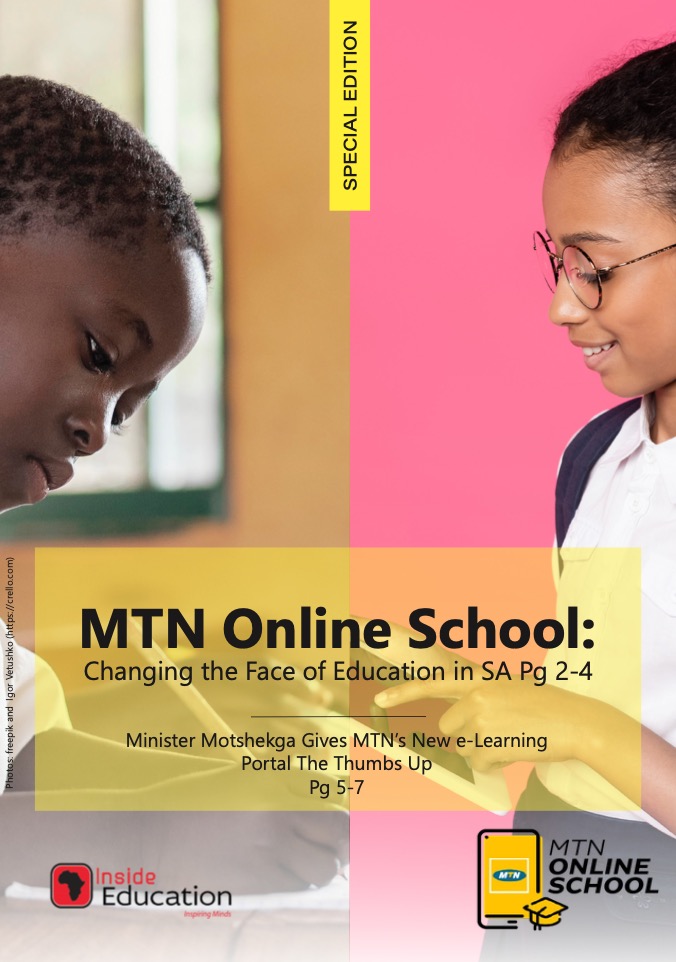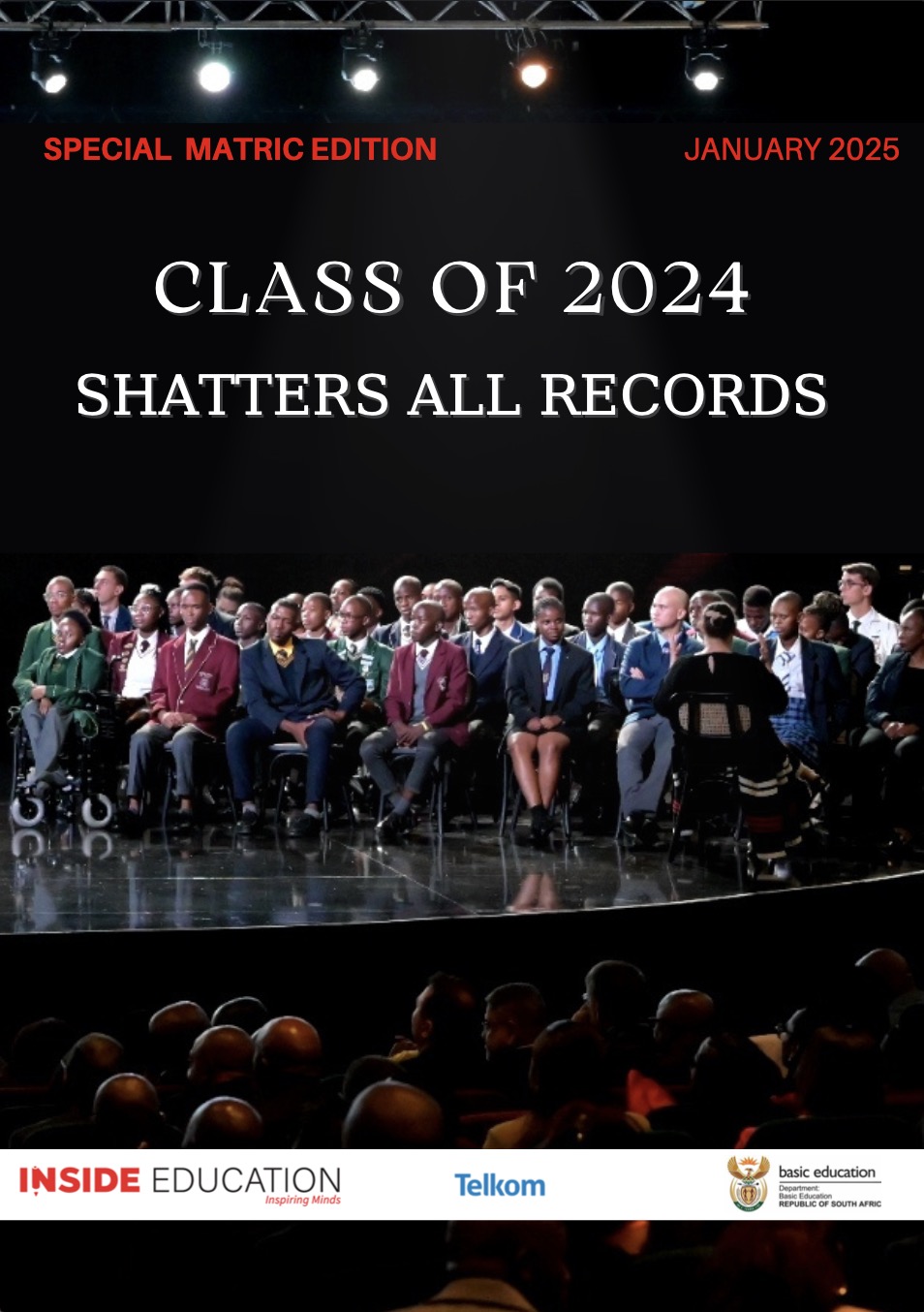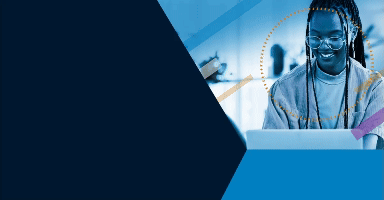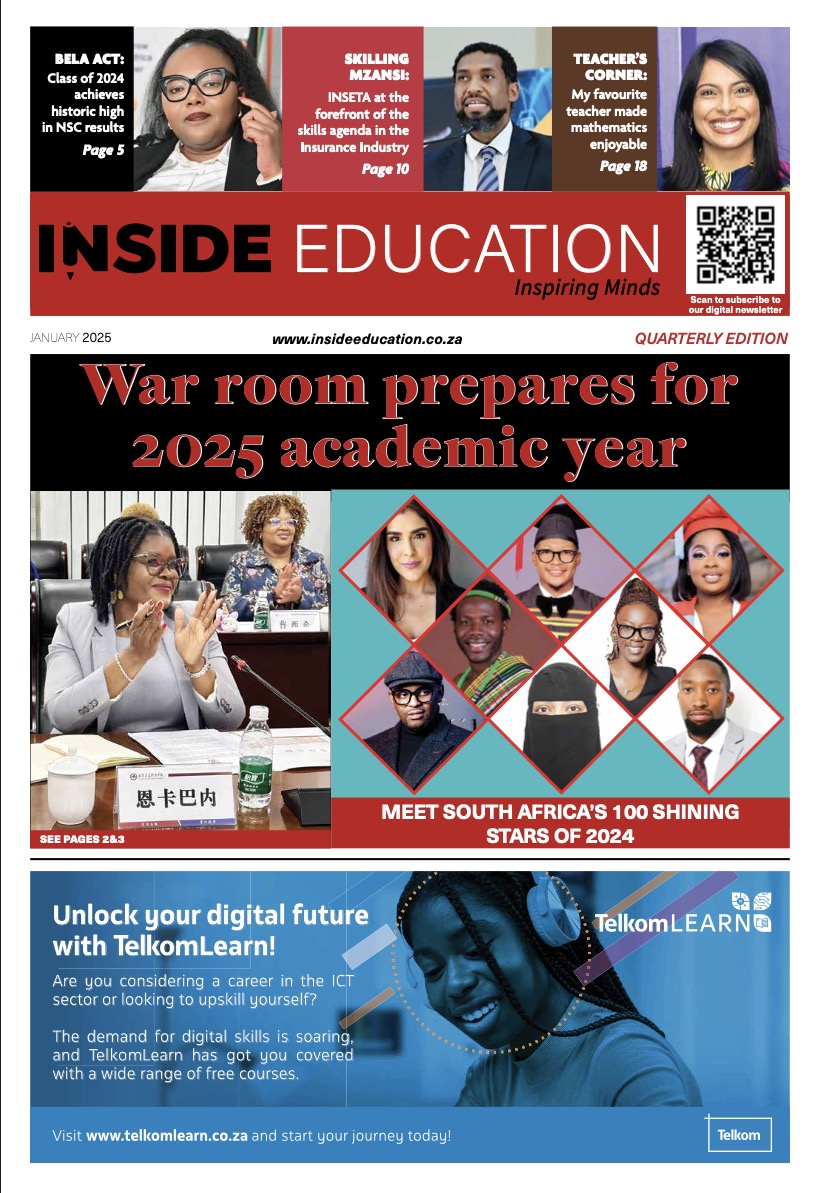DESMOND THOMPSON
When the news broke in May that South Africa had come last in a global assessment of reading achievement, it caused a nationwide outcry. This special report examines the findings, speaks to experts to make sense of it all, and looks at the prospects of improvements.
Our “child literacy rates are a disgrace,” Business Day said in an editorial the day after the findings of the latest Progress in International Reading Literacy Study (Pirls) were released on 16 May 2023, showing that four out of every five Grade 4s tested in South Africa (SA) in 2021 could not “read for meaning”.
This level of reading is the highest “be- cause it requires that our children are empowered to analyse and interpret information and make deductions and inferences, which demonstrate their ability to organise and internalise facts logically, systematically and coherently,” Basic Education Minister Angie Motshekga explained to parliament in her department’s budget vote two days later.
That only 19% of Grade 4s had shown they could do these things was described as a “generational catastrophe” by Nic Spaull, associate professor in Economics and research fellow with the Research on Socioeconomic Policy (Resep) group at Stellenbosch University (SU). His sentiment would be echoed in numerous news reports and op-eds over the next few days and weeks.
Last year, Mathanzima Mweli, director-general of the Department of Basic Education (DBE), wrote that learners “who do not acquire the foundational skills necessary for proficient reading remain perpetually behind, as their ability to process, interpret and understand grade-level texts is largely impeded.”
Reading-for-meaning tests are conducted in Grade 4 because it is considered an important transition point in children’s development, when they are supposed to go from “learning to read” to “reading to learn”, according to the Pirls website.
What is Pirls?
Pirls is a “regular international comparative assessment of student achievement in reading,” an initiative of the International Association for the Evaluation of Educational Achievement, headquartered in Amsterdam.
Since 2001, Pirls has been conducted every five years by the International Study Centre of Boston College’s Lynch School of Education and Human Development. In SA, Pirls is undertaken by the Centre for Evaluation and Assessment of the University of Pretoria’s Faculty of Education.
SA has been participating in Pirls since 2006 and was one of 57 countries which took part in 2021. It was the only sub-Saharan African country in the study; the other participants from the continent were Egypt and Morocco. The relatively few other developing countries included Jordan and Brazil. A total of 12 426 of our Grade-4 learners in 321 schools were assessed, representing all our official languages (11 at that stage) and all nine provinces.
How did we do?
• SA’s score dropped from 78% of Grade 4s not being able to read for meaning in 2016 to 81% in 2021. This is scarcely better than our 82% in 2011, which means the country has lost an entire decade of progress.
• Learners writing in Afrikaans and English maintained their performance, while the performance of those writing in SA’s other official languages worsened.
• Results in all provinces deteriorated, but the Western Cape, Gauteng and KwaZulu-Natal performed better than the national average.
The impact of Covid-19
Motshekga blamed the weakening of SA’s results on the “devastating effects of the Covid-19 pandemic on teaching and learning.”

In an op-ed in Daily Maverick, Nompumelelo Mohohlwane, the DBE’s deputy director for research, monitoring and evaluation, concurred: “The decline is extremely unfortunate, but it was not sur- prising because school closure was one of the early responses to the Covid-19 pandemic. In SA, this led to the loss of about 60% of the academic year in 2020 and 50% in 2021.”
Inequality
As to why the performance of Grade-4 learners who wrote the tests in African languages was worse than the results of those who wrote in Afrikaans and English, Motshekga blamed “our regrettable past”.
This was a reference to the stratification of education under apartheid in terms of class and race.

In an interview with Inside Education, Prof Servaas van der Berg, who holds the SA National Research Chair in the Economics of Social Policy, based at SU, confirmed that there was a close correlation between the socio-economic status of schools and their feeder communities, on the one hand, and the academic performance of their learners, on the other.
“Better performing learners and schools tend to come from wealthier communities. There are exceptions, but unfortunately, we do not have enough examples of good performance, in general, coming from poorer communities and schools. It seems to be a question of resources, at least partly,” he said.
He ascribed that the Western Cape and Gauteng showed the most minor decline in Pirls to the fact that “they are, in the first instance, our wealthier provinces.”
The DBE looks at the levels of income, literacy and unemployment in a community to determine a school’s ranking. Quintile-1 to -3 schools are no-fee paying schools, and quintile-4 and five schools may charge fees.
According to Van der Berg, nearly two-thirds of Western Cape learners are in quintile-4 and -5 schools. They tend to have better facilities, and their learners also tend to have greater access to books, computers and the internet at home – resources that are in short supply in poorer schools and communities.
Language
The Pirls results also reflect South Africa’s complexities in terms of language.
“About 70% of learners in South Africa are in no-fee schools that use an African language as the language of instruction for the first three grades. During this time, most children learn English as a subject and then experience a switch in Grade 4 when English becomes the language of instruction. Their African languages become a subject,” Mohohlwane wrote.
“In contrast, about 9% of learners start school in Afrikaans and do not switch at any stage but continue with Afrikaans after Grade 4 until matric. Similarly, the 23% that start in English continue past Grade 4 without any language switching.”
However, she argued, it “would be a mistake to blame the African languages for the decline,” adding that “it remains the right decision to start school in the language you know best.”
Spaull agrees that “the legacy of colonialism and apartheid is very much still with us” but argues, “That doesn’t mean there is not more that we could do to redress that legacy – we have proven interventions about what works to improve reading in no-fee schools, but we are not doing them.”
What can be done?
In a synthesis report released in 2022, the DBE says foundation-level reading has been high on its agenda since at least 2012.
By 2019, this emphasis had found its way into President Cyril Ramaphosa’s State of the Nation Address, when he said that “substantially improving reading comprehension in the first years of school” had become a “critical priority”.
The master plan to give effect to this goal was supposed to be the National Reading Strategy, also launched that year. However, it suffered from some fundamental flaws, which – according to Spaull – included having “no credible milestones and no credible plan of achieving it.”
Then Covid-19 struck, and school closures and rotational timetables wrought their damage, as reflected by the 2021 Pirls findings.
Now, an improved plan is in the pipeline – the National Integrated Reading Literacy.
The strategy mentioned by Motshekga in the DBE’s budget vote. She said there had been “lessons learnt”, one of which seems to be prioritisation. The plan’s “10 pillars” of old will be reduced to “four key interdependent strands”.
Inside Education got more details from Mohohlwane on what the new plan due to be launched might contain:
• Policy: There will be an emphasis on home language literacy in the foundation phase.
• Teachers: In-depth training and support through such mechanisms as ex- pert reading coaches, workshops, and daily lesson plans.
• Materials: Such ideas as graded readers, flashcards, posters, big books, and alphabet friezes are integrated into lesson plans to ensure they are used appropriately within a coherent lesson.
• Parents and communities: Advocacy about the importance of fostering reading enjoyment among children.
Triple cocktail
In its synthesis report, the DBE said it had found that a “triple cocktail” of daily lesson plans, quality integrated reading materials and on-site coaching resulted in an extra 40% of learning at the end of one year.
These ideas were derived from a series of large-scale evaluations since 2015 in North West and Limpopo to build a scientific evidence base about what interventions have the most significant impact on reading outcomes and how the change process works.
Incubating ideas
Non-governmental organisations (NGOs), such as Funda Wande, are also helping to look for solutions.

“We incubate ideas that we think would work. At the moment, we are trying different models in three provinces,” Dr Nwabisa Makaluza, head of research and development, told Inside Education.
“In the Eastern Cape, we are trialling coaching, both by outside experts and by equipping schools’ heads of departments to become coaches.
“In Limpopo, our teaching assistant model was very effective, and we also got good results from providing schools with learning and teaching support materials.
“And our latest project is in the Western Cape, where the provincial education department is doing the rollout themselves in about 50 schools. Elements include reading coaches, monitoring and evaluation.”
Collaboration
Makaluza says public-private partnerships are essential.
“We are under no illusion that we can do this alone. We do not even start at a school without building a relationship with the relevant education department because they are the schools’ custodians.
“And when we get the results of our trials, we always feed it back to the departments – so they can learn with us. Collaboration is essential.”
Benchmarking

Dr Zelda Barends, a senior lecturer in curriculum studies at SU’s Faculty of Education, is part of the DBE’s benchmarking process for learning to read in the foundation phase. The benchmarks were developed through collaboration between education technocrats, reading experts, linguists and quantitative experts.
Grade-specific reading benchmarks pro- vide the tools to measure whether learners are on-track to reading for meaning by the end of the foundation phase. The benchmarks for each language differ, but they all include the following:
• By the end of Grade 1, all learners should be able to sound a certain number of letters per minute correctly.
• By the end of Grade 2, all learners should be able to read a certain number of words within a passage correctly.
• This tally would go up for Grade 3.
The benchmarks are set high enough to support system-wide improvements yet not so high as to be unattainable. Learners achieving the required fluency are increasingly able to comprehend what they are reading and would therefore be able to transition to the next stage, the intermediate phase.
The benchmarks are intended for use by teachers, school leaders and provinces, as well as the national department, to support reading in South Africa’s official languages.
Principals
Barends says the role of principals is something that is often overlooked.
“If we start investing in school leadership, we would be able to turn the problem of reading around slowly but surely, because when there’s a visionary leader, someone who believes in what they’re doing and knows how to work with other people and get the most out of them, things change for the better.”
Teachers
Some commentators say some teachers are part of the problem – those who are not motivated, for whatever reason, and don’t give their best.
However, Barends said, “Teachers need some grace in the system.”
“Most of them are working very hard, but they are getting flak from all sides. They are expected to achieve high outcomes with all the learners that come to them, but the learners are at different levels, and sometimes the teachers have not had the specialised training they need to teach learners to read.”
That is why teacher empowerment is considered vital by the DBE.
In its 2022 synthesis report, the Department said that teacher support interventions had positive impacts on reading outcomes, mainly on-site coaching.
Mohohlwane said that teachers some- times resisted interventions they experienced as critical of their abilities but that it was possible to overcome this problem.
“In our coaching interventions, we have coined the term ‘critical friend’ because they visit often, build up a relationship with the same teacher, and most importantly, only with them. They don’t report to the principal or anyone else in the system. It’s not linked to a teacher’s performance review or promotion or anything like that.
They are just an expert resource to help the teacher teach children to read. It may take teachers three or six months to relax with this per- son, but then they say they feel supported.”
Accountability
Some analysts have identified a lack of accountability by teachers and principals, and schools – especially at the foundation phase level – as a significant part of the problem.
“In a democracy, the role of civil society is to hold the government to account for what it says it is doing and what its constitutional obligations are,” Spaull told Inside Education.
He thinks the fact that the Pirls results have caused an outcry is putting pressure on the DBE, which might result in quicker results.
Pace of change
The Parliamentary Monitoring Group reported that when Motshekga briefed parliament about Pirls on 23 May, she said, “Education was like growing a tree, not like carrots”, – meaning that it takes time to get results.
Her statement might be accurate but is unlikely to satisfy South Africans who want urgent action to avoid losing another generation.
Before the Covid-19 shock, SA was making good progress in improving early-grade reading scores. Between the 2011 and 2016 Pirls cycles, SA showed the second-fastest improvement among all participating countries, after Morocco.
The question is now whether we can return to that pace and even speed things up.
Mohohlwane is optimistic: “The planning and testing and policy formulation and lobbying have been ten years in the making, and now things are coming together.
If it were not for Covid, we would have been further along. Now we must redouble our efforts to make progress. We will get there incrementally.”
Special time
Makaluza agrees: “I find the current push from the public, academia, the media, the rest of civil society and even from within government and the education departments, national and provincial, interesting. It’s a special time of consensus that we need a drastic change, which might give us the push we need.”
* Thompson is a freelance journalist.
INSIDE EDUCATION








